NUR3030 - Aboriginal Health: Bridging Cultural Beliefs & Healthcare
VerifiedAdded on 2023/05/29
|9
|2235
|204
Essay
AI Summary
This essay delves into the disparity between Aboriginal health beliefs and Western healthcare practices, highlighting the challenges faced in service delivery. It emphasizes the importance of cultural safety, guided by principles such as understanding cultural backgrounds, minimizing power differentials, and engaging clients in their health status. The essay discusses traditional Aboriginal models that attribute illness to social, spiritual dysfunction, or supernatural intervention, contrasting them with Western medical explanations. It explores various forms of traditional treatment, including bush medicine and traditional healers, and advocates for a combination of traditional and Western interventions to minimize power differentials and provide comprehensive care. The essay also addresses the historical mistrust stemming from European colonization and its impact on healthcare service provision, emphasizing the need for nurses to promote trust and respect cultural beliefs, particularly concerning grief and loss. It further examines how language barriers, cultural preferences, and healthcare system limitations affect nursing care for Aboriginal people, advocating for community involvement, collaborative approaches, and continuous training to improve primary healthcare delivery. Desklib offers additional resources for students studying similar topics.
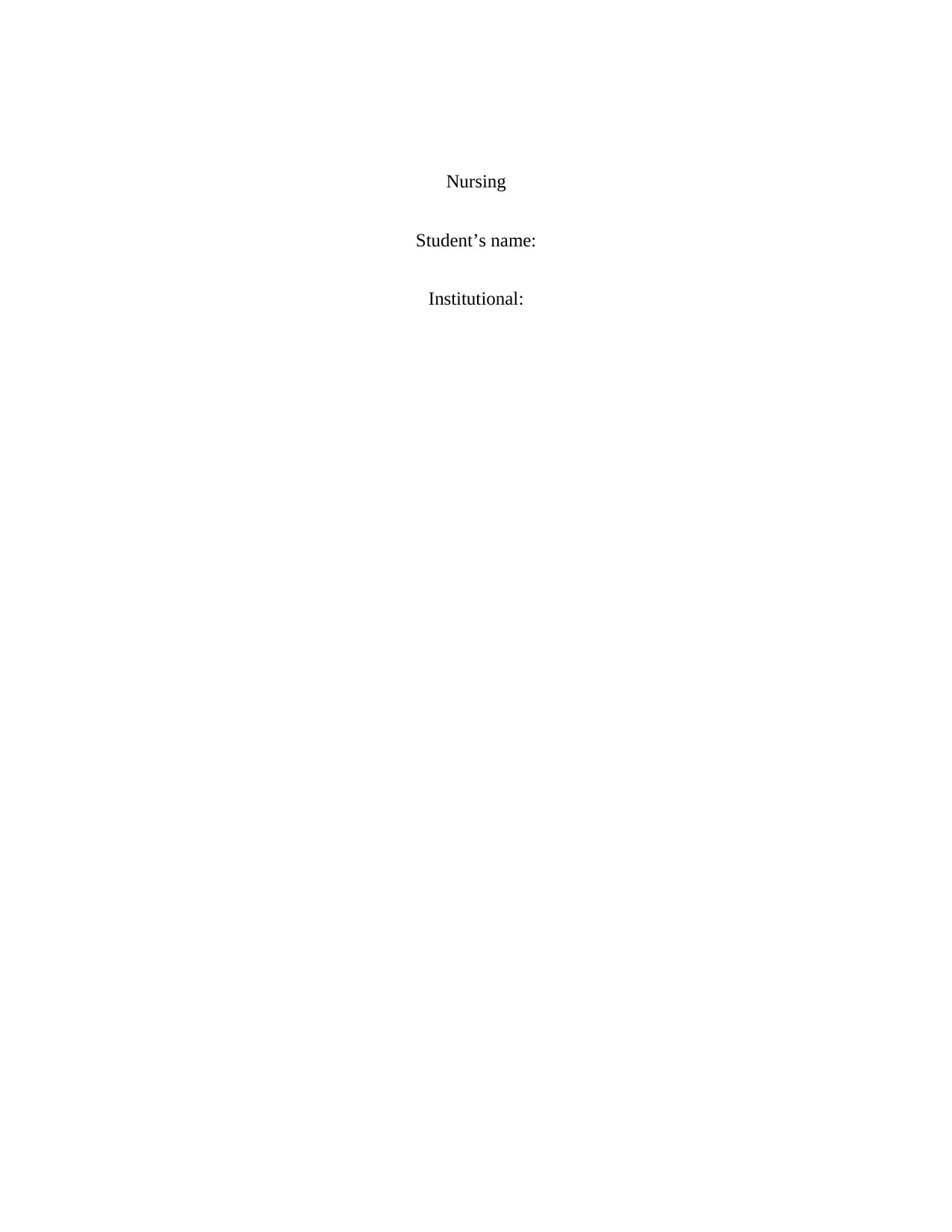
Nursing
Student’s name:
Institutional:
Student’s name:
Institutional:
Paraphrase This Document
Need a fresh take? Get an instant paraphrase of this document with our AI Paraphraser
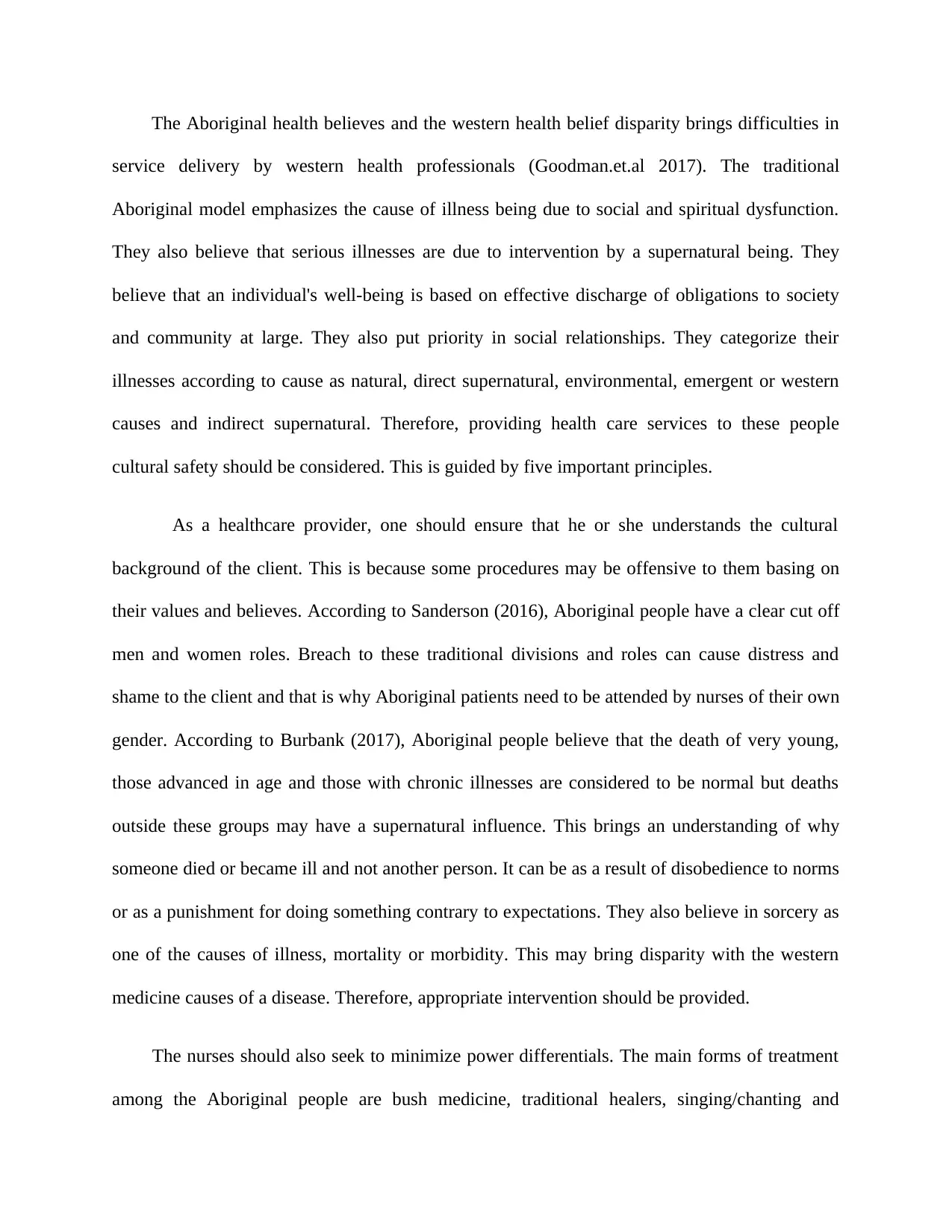
The Aboriginal health believes and the western health belief disparity brings difficulties in
service delivery by western health professionals (Goodman.et.al 2017). The traditional
Aboriginal model emphasizes the cause of illness being due to social and spiritual dysfunction.
They also believe that serious illnesses are due to intervention by a supernatural being. They
believe that an individual's well-being is based on effective discharge of obligations to society
and community at large. They also put priority in social relationships. They categorize their
illnesses according to cause as natural, direct supernatural, environmental, emergent or western
causes and indirect supernatural. Therefore, providing health care services to these people
cultural safety should be considered. This is guided by five important principles.
As a healthcare provider, one should ensure that he or she understands the cultural
background of the client. This is because some procedures may be offensive to them basing on
their values and believes. According to Sanderson (2016), Aboriginal people have a clear cut off
men and women roles. Breach to these traditional divisions and roles can cause distress and
shame to the client and that is why Aboriginal patients need to be attended by nurses of their own
gender. According to Burbank (2017), Aboriginal people believe that the death of very young,
those advanced in age and those with chronic illnesses are considered to be normal but deaths
outside these groups may have a supernatural influence. This brings an understanding of why
someone died or became ill and not another person. It can be as a result of disobedience to norms
or as a punishment for doing something contrary to expectations. They also believe in sorcery as
one of the causes of illness, mortality or morbidity. This may bring disparity with the western
medicine causes of a disease. Therefore, appropriate intervention should be provided.
The nurses should also seek to minimize power differentials. The main forms of treatment
among the Aboriginal people are bush medicine, traditional healers, singing/chanting and
service delivery by western health professionals (Goodman.et.al 2017). The traditional
Aboriginal model emphasizes the cause of illness being due to social and spiritual dysfunction.
They also believe that serious illnesses are due to intervention by a supernatural being. They
believe that an individual's well-being is based on effective discharge of obligations to society
and community at large. They also put priority in social relationships. They categorize their
illnesses according to cause as natural, direct supernatural, environmental, emergent or western
causes and indirect supernatural. Therefore, providing health care services to these people
cultural safety should be considered. This is guided by five important principles.
As a healthcare provider, one should ensure that he or she understands the cultural
background of the client. This is because some procedures may be offensive to them basing on
their values and believes. According to Sanderson (2016), Aboriginal people have a clear cut off
men and women roles. Breach to these traditional divisions and roles can cause distress and
shame to the client and that is why Aboriginal patients need to be attended by nurses of their own
gender. According to Burbank (2017), Aboriginal people believe that the death of very young,
those advanced in age and those with chronic illnesses are considered to be normal but deaths
outside these groups may have a supernatural influence. This brings an understanding of why
someone died or became ill and not another person. It can be as a result of disobedience to norms
or as a punishment for doing something contrary to expectations. They also believe in sorcery as
one of the causes of illness, mortality or morbidity. This may bring disparity with the western
medicine causes of a disease. Therefore, appropriate intervention should be provided.
The nurses should also seek to minimize power differentials. The main forms of treatment
among the Aboriginal people are bush medicine, traditional healers, singing/chanting and
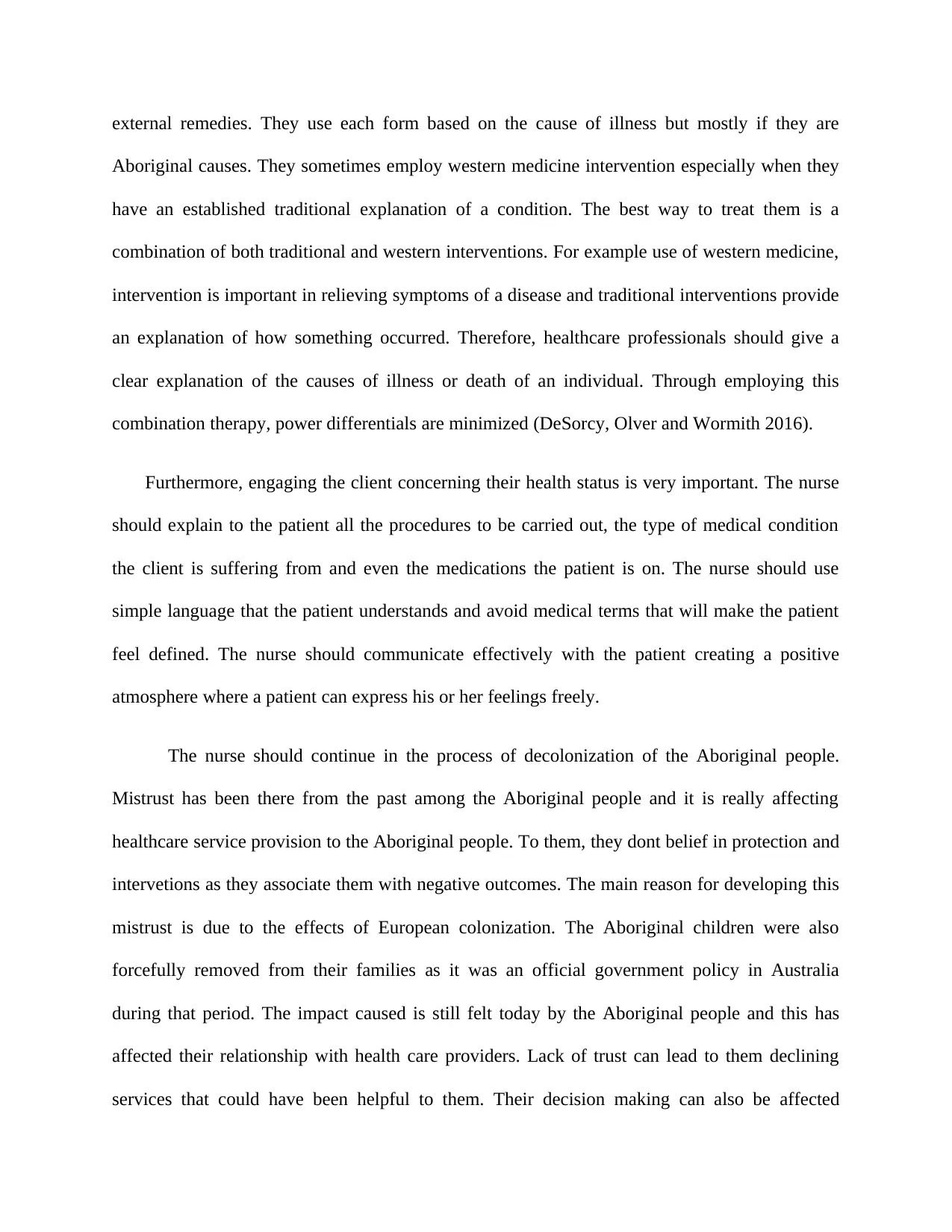
external remedies. They use each form based on the cause of illness but mostly if they are
Aboriginal causes. They sometimes employ western medicine intervention especially when they
have an established traditional explanation of a condition. The best way to treat them is a
combination of both traditional and western interventions. For example use of western medicine,
intervention is important in relieving symptoms of a disease and traditional interventions provide
an explanation of how something occurred. Therefore, healthcare professionals should give a
clear explanation of the causes of illness or death of an individual. Through employing this
combination therapy, power differentials are minimized (DeSorcy, Olver and Wormith 2016).
Furthermore, engaging the client concerning their health status is very important. The nurse
should explain to the patient all the procedures to be carried out, the type of medical condition
the client is suffering from and even the medications the patient is on. The nurse should use
simple language that the patient understands and avoid medical terms that will make the patient
feel defined. The nurse should communicate effectively with the patient creating a positive
atmosphere where a patient can express his or her feelings freely.
The nurse should continue in the process of decolonization of the Aboriginal people.
Mistrust has been there from the past among the Aboriginal people and it is really affecting
healthcare service provision to the Aboriginal people. To them, they dont belief in protection and
intervetions as they associate them with negative outcomes. The main reason for developing this
mistrust is due to the effects of European colonization. The Aboriginal children were also
forcefully removed from their families as it was an official government policy in Australia
during that period. The impact caused is still felt today by the Aboriginal people and this has
affected their relationship with health care providers. Lack of trust can lead to them declining
services that could have been helpful to them. Their decision making can also be affected
Aboriginal causes. They sometimes employ western medicine intervention especially when they
have an established traditional explanation of a condition. The best way to treat them is a
combination of both traditional and western interventions. For example use of western medicine,
intervention is important in relieving symptoms of a disease and traditional interventions provide
an explanation of how something occurred. Therefore, healthcare professionals should give a
clear explanation of the causes of illness or death of an individual. Through employing this
combination therapy, power differentials are minimized (DeSorcy, Olver and Wormith 2016).
Furthermore, engaging the client concerning their health status is very important. The nurse
should explain to the patient all the procedures to be carried out, the type of medical condition
the client is suffering from and even the medications the patient is on. The nurse should use
simple language that the patient understands and avoid medical terms that will make the patient
feel defined. The nurse should communicate effectively with the patient creating a positive
atmosphere where a patient can express his or her feelings freely.
The nurse should continue in the process of decolonization of the Aboriginal people.
Mistrust has been there from the past among the Aboriginal people and it is really affecting
healthcare service provision to the Aboriginal people. To them, they dont belief in protection and
intervetions as they associate them with negative outcomes. The main reason for developing this
mistrust is due to the effects of European colonization. The Aboriginal children were also
forcefully removed from their families as it was an official government policy in Australia
during that period. The impact caused is still felt today by the Aboriginal people and this has
affected their relationship with health care providers. Lack of trust can lead to them declining
services that could have been helpful to them. Their decision making can also be affected
⊘ This is a preview!⊘
Do you want full access?
Subscribe today to unlock all pages.

Trusted by 1+ million students worldwide
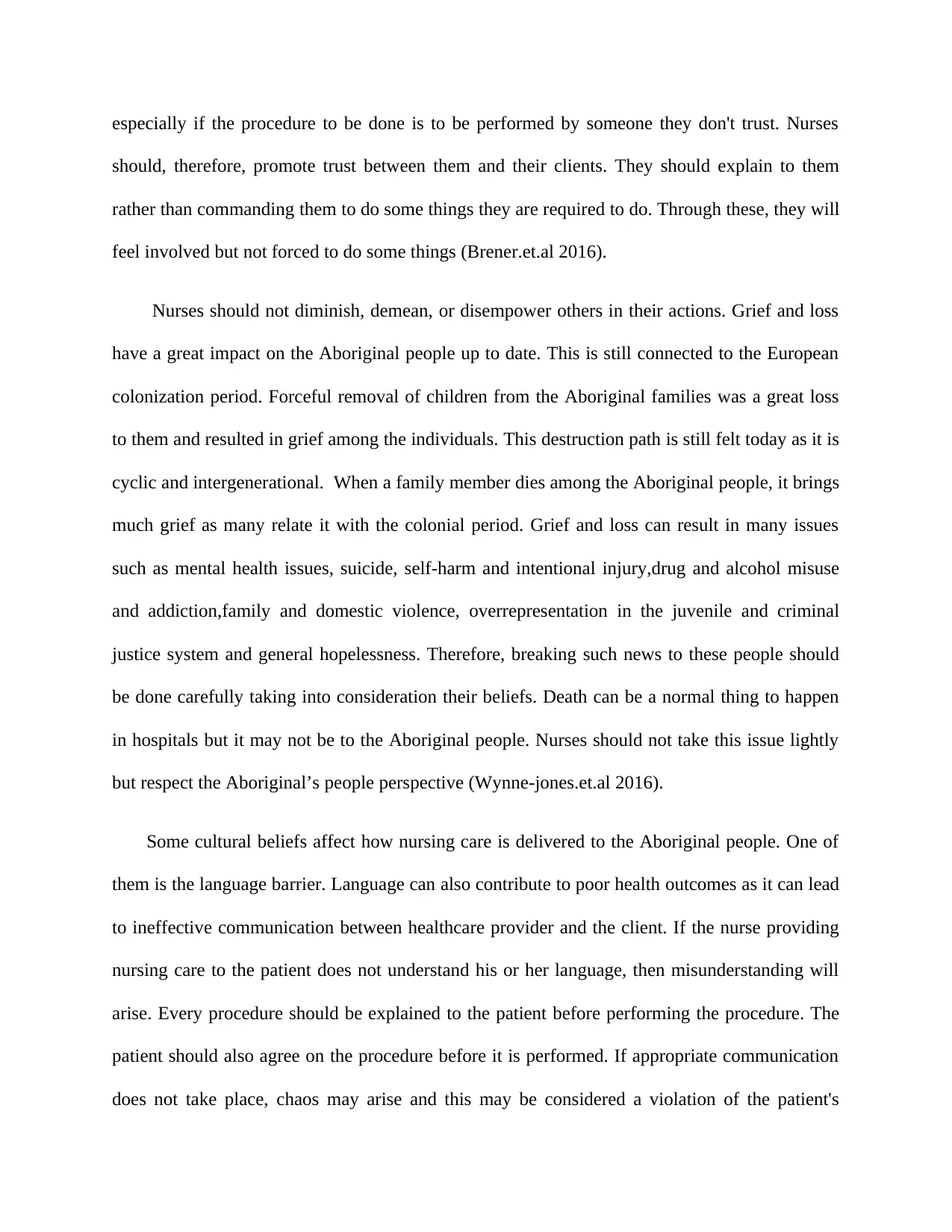
especially if the procedure to be done is to be performed by someone they don't trust. Nurses
should, therefore, promote trust between them and their clients. They should explain to them
rather than commanding them to do some things they are required to do. Through these, they will
feel involved but not forced to do some things (Brener.et.al 2016).
Nurses should not diminish, demean, or disempower others in their actions. Grief and loss
have a great impact on the Aboriginal people up to date. This is still connected to the European
colonization period. Forceful removal of children from the Aboriginal families was a great loss
to them and resulted in grief among the individuals. This destruction path is still felt today as it is
cyclic and intergenerational. When a family member dies among the Aboriginal people, it brings
much grief as many relate it with the colonial period. Grief and loss can result in many issues
such as mental health issues, suicide, self-harm and intentional injury,drug and alcohol misuse
and addiction,family and domestic violence, overrepresentation in the juvenile and criminal
justice system and general hopelessness. Therefore, breaking such news to these people should
be done carefully taking into consideration their beliefs. Death can be a normal thing to happen
in hospitals but it may not be to the Aboriginal people. Nurses should not take this issue lightly
but respect the Aboriginal’s people perspective (Wynne-jones.et.al 2016).
Some cultural beliefs affect how nursing care is delivered to the Aboriginal people. One of
them is the language barrier. Language can also contribute to poor health outcomes as it can lead
to ineffective communication between healthcare provider and the client. If the nurse providing
nursing care to the patient does not understand his or her language, then misunderstanding will
arise. Every procedure should be explained to the patient before performing the procedure. The
patient should also agree on the procedure before it is performed. If appropriate communication
does not take place, chaos may arise and this may be considered a violation of the patient's
should, therefore, promote trust between them and their clients. They should explain to them
rather than commanding them to do some things they are required to do. Through these, they will
feel involved but not forced to do some things (Brener.et.al 2016).
Nurses should not diminish, demean, or disempower others in their actions. Grief and loss
have a great impact on the Aboriginal people up to date. This is still connected to the European
colonization period. Forceful removal of children from the Aboriginal families was a great loss
to them and resulted in grief among the individuals. This destruction path is still felt today as it is
cyclic and intergenerational. When a family member dies among the Aboriginal people, it brings
much grief as many relate it with the colonial period. Grief and loss can result in many issues
such as mental health issues, suicide, self-harm and intentional injury,drug and alcohol misuse
and addiction,family and domestic violence, overrepresentation in the juvenile and criminal
justice system and general hopelessness. Therefore, breaking such news to these people should
be done carefully taking into consideration their beliefs. Death can be a normal thing to happen
in hospitals but it may not be to the Aboriginal people. Nurses should not take this issue lightly
but respect the Aboriginal’s people perspective (Wynne-jones.et.al 2016).
Some cultural beliefs affect how nursing care is delivered to the Aboriginal people. One of
them is the language barrier. Language can also contribute to poor health outcomes as it can lead
to ineffective communication between healthcare provider and the client. If the nurse providing
nursing care to the patient does not understand his or her language, then misunderstanding will
arise. Every procedure should be explained to the patient before performing the procedure. The
patient should also agree on the procedure before it is performed. If appropriate communication
does not take place, chaos may arise and this may be considered a violation of the patient's
Paraphrase This Document
Need a fresh take? Get an instant paraphrase of this document with our AI Paraphraser
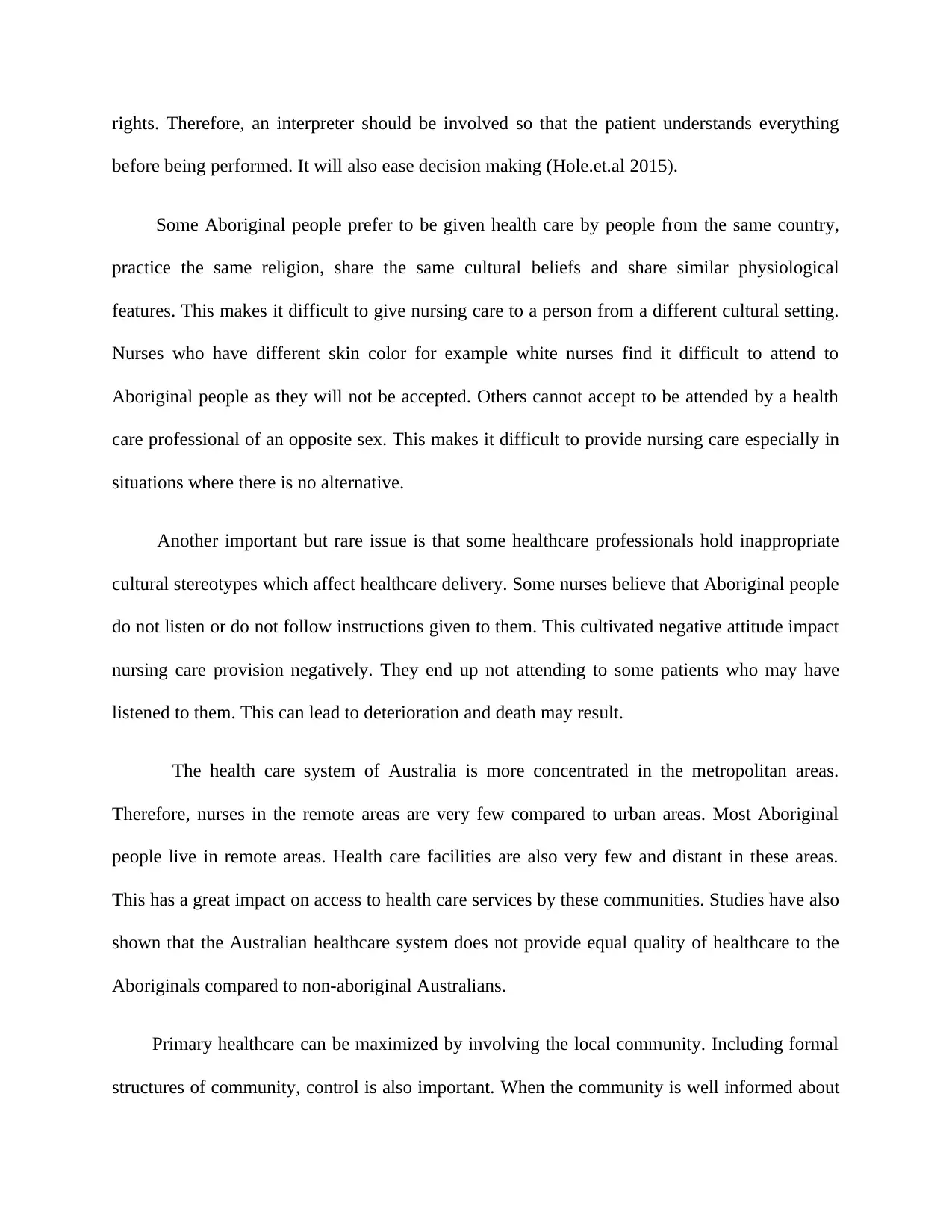
rights. Therefore, an interpreter should be involved so that the patient understands everything
before being performed. It will also ease decision making (Hole.et.al 2015).
Some Aboriginal people prefer to be given health care by people from the same country,
practice the same religion, share the same cultural beliefs and share similar physiological
features. This makes it difficult to give nursing care to a person from a different cultural setting.
Nurses who have different skin color for example white nurses find it difficult to attend to
Aboriginal people as they will not be accepted. Others cannot accept to be attended by a health
care professional of an opposite sex. This makes it difficult to provide nursing care especially in
situations where there is no alternative.
Another important but rare issue is that some healthcare professionals hold inappropriate
cultural stereotypes which affect healthcare delivery. Some nurses believe that Aboriginal people
do not listen or do not follow instructions given to them. This cultivated negative attitude impact
nursing care provision negatively. They end up not attending to some patients who may have
listened to them. This can lead to deterioration and death may result.
The health care system of Australia is more concentrated in the metropolitan areas.
Therefore, nurses in the remote areas are very few compared to urban areas. Most Aboriginal
people live in remote areas. Health care facilities are also very few and distant in these areas.
This has a great impact on access to health care services by these communities. Studies have also
shown that the Australian healthcare system does not provide equal quality of healthcare to the
Aboriginals compared to non-aboriginal Australians.
Primary healthcare can be maximized by involving the local community. Including formal
structures of community, control is also important. When the community is well informed about
before being performed. It will also ease decision making (Hole.et.al 2015).
Some Aboriginal people prefer to be given health care by people from the same country,
practice the same religion, share the same cultural beliefs and share similar physiological
features. This makes it difficult to give nursing care to a person from a different cultural setting.
Nurses who have different skin color for example white nurses find it difficult to attend to
Aboriginal people as they will not be accepted. Others cannot accept to be attended by a health
care professional of an opposite sex. This makes it difficult to provide nursing care especially in
situations where there is no alternative.
Another important but rare issue is that some healthcare professionals hold inappropriate
cultural stereotypes which affect healthcare delivery. Some nurses believe that Aboriginal people
do not listen or do not follow instructions given to them. This cultivated negative attitude impact
nursing care provision negatively. They end up not attending to some patients who may have
listened to them. This can lead to deterioration and death may result.
The health care system of Australia is more concentrated in the metropolitan areas.
Therefore, nurses in the remote areas are very few compared to urban areas. Most Aboriginal
people live in remote areas. Health care facilities are also very few and distant in these areas.
This has a great impact on access to health care services by these communities. Studies have also
shown that the Australian healthcare system does not provide equal quality of healthcare to the
Aboriginals compared to non-aboriginal Australians.
Primary healthcare can be maximized by involving the local community. Including formal
structures of community, control is also important. When the community is well informed about
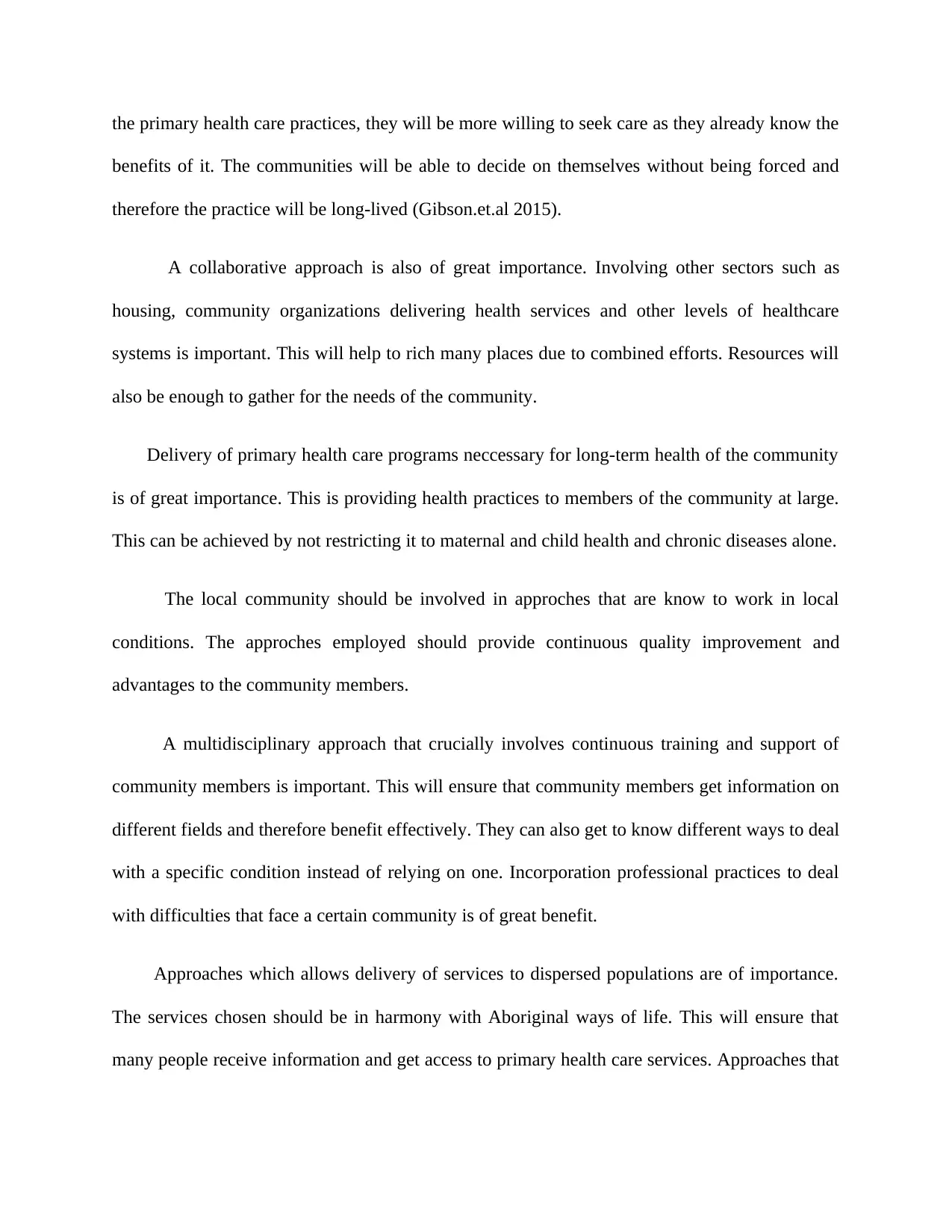
the primary health care practices, they will be more willing to seek care as they already know the
benefits of it. The communities will be able to decide on themselves without being forced and
therefore the practice will be long-lived (Gibson.et.al 2015).
A collaborative approach is also of great importance. Involving other sectors such as
housing, community organizations delivering health services and other levels of healthcare
systems is important. This will help to rich many places due to combined efforts. Resources will
also be enough to gather for the needs of the community.
Delivery of primary health care programs neccessary for long-term health of the community
is of great importance. This is providing health practices to members of the community at large.
This can be achieved by not restricting it to maternal and child health and chronic diseases alone.
The local community should be involved in approches that are know to work in local
conditions. The approches employed should provide continuous quality improvement and
advantages to the community members.
A multidisciplinary approach that crucially involves continuous training and support of
community members is important. This will ensure that community members get information on
different fields and therefore benefit effectively. They can also get to know different ways to deal
with a specific condition instead of relying on one. Incorporation professional practices to deal
with difficulties that face a certain community is of great benefit.
Approaches which allows delivery of services to dispersed populations are of importance.
The services chosen should be in harmony with Aboriginal ways of life. This will ensure that
many people receive information and get access to primary health care services. Approaches that
benefits of it. The communities will be able to decide on themselves without being forced and
therefore the practice will be long-lived (Gibson.et.al 2015).
A collaborative approach is also of great importance. Involving other sectors such as
housing, community organizations delivering health services and other levels of healthcare
systems is important. This will help to rich many places due to combined efforts. Resources will
also be enough to gather for the needs of the community.
Delivery of primary health care programs neccessary for long-term health of the community
is of great importance. This is providing health practices to members of the community at large.
This can be achieved by not restricting it to maternal and child health and chronic diseases alone.
The local community should be involved in approches that are know to work in local
conditions. The approches employed should provide continuous quality improvement and
advantages to the community members.
A multidisciplinary approach that crucially involves continuous training and support of
community members is important. This will ensure that community members get information on
different fields and therefore benefit effectively. They can also get to know different ways to deal
with a specific condition instead of relying on one. Incorporation professional practices to deal
with difficulties that face a certain community is of great benefit.
Approaches which allows delivery of services to dispersed populations are of importance.
The services chosen should be in harmony with Aboriginal ways of life. This will ensure that
many people receive information and get access to primary health care services. Approaches that
⊘ This is a preview!⊘
Do you want full access?
Subscribe today to unlock all pages.

Trusted by 1+ million students worldwide
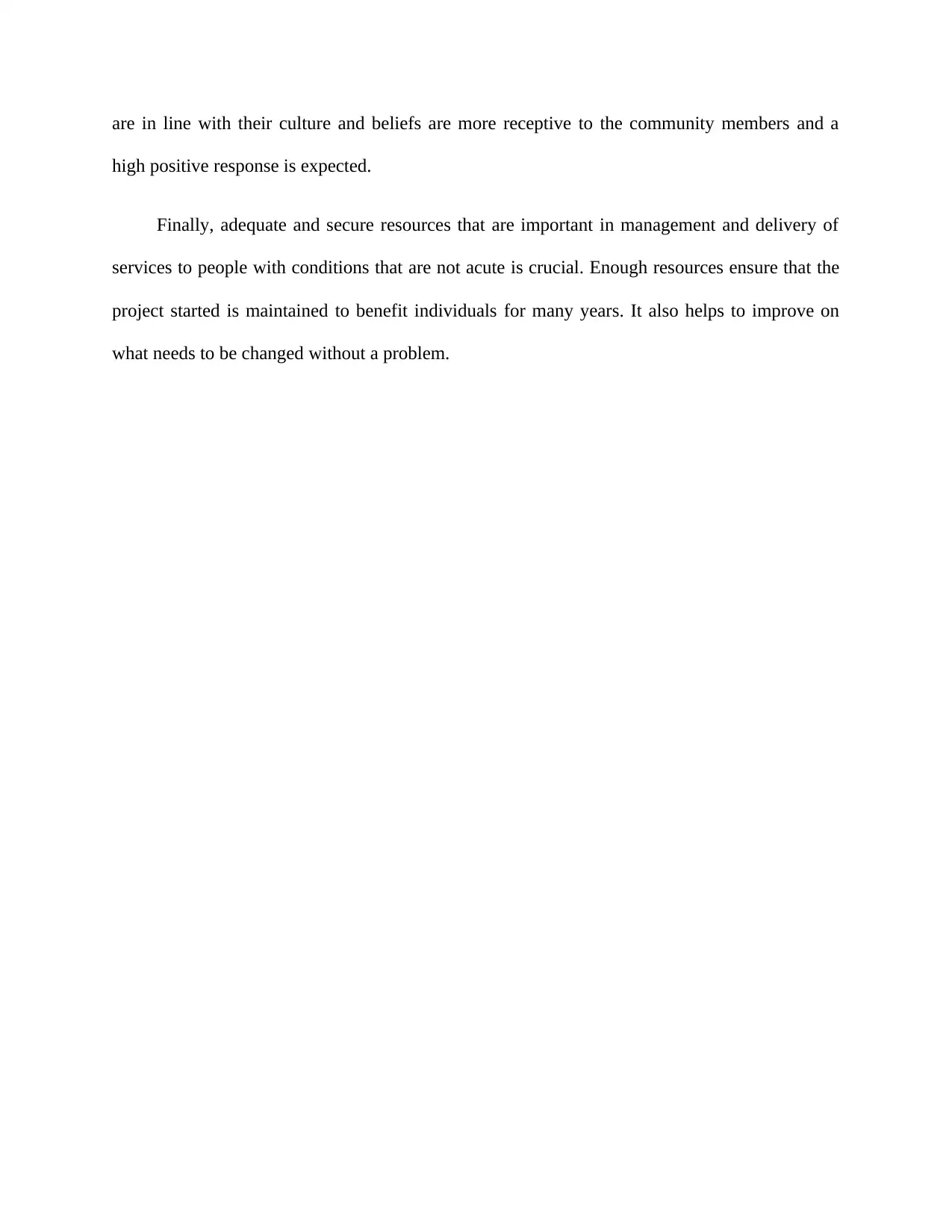
are in line with their culture and beliefs are more receptive to the community members and a
high positive response is expected.
Finally, adequate and secure resources that are important in management and delivery of
services to people with conditions that are not acute is crucial. Enough resources ensure that the
project started is maintained to benefit individuals for many years. It also helps to improve on
what needs to be changed without a problem.
high positive response is expected.
Finally, adequate and secure resources that are important in management and delivery of
services to people with conditions that are not acute is crucial. Enough resources ensure that the
project started is maintained to benefit individuals for many years. It also helps to improve on
what needs to be changed without a problem.
Paraphrase This Document
Need a fresh take? Get an instant paraphrase of this document with our AI Paraphraser
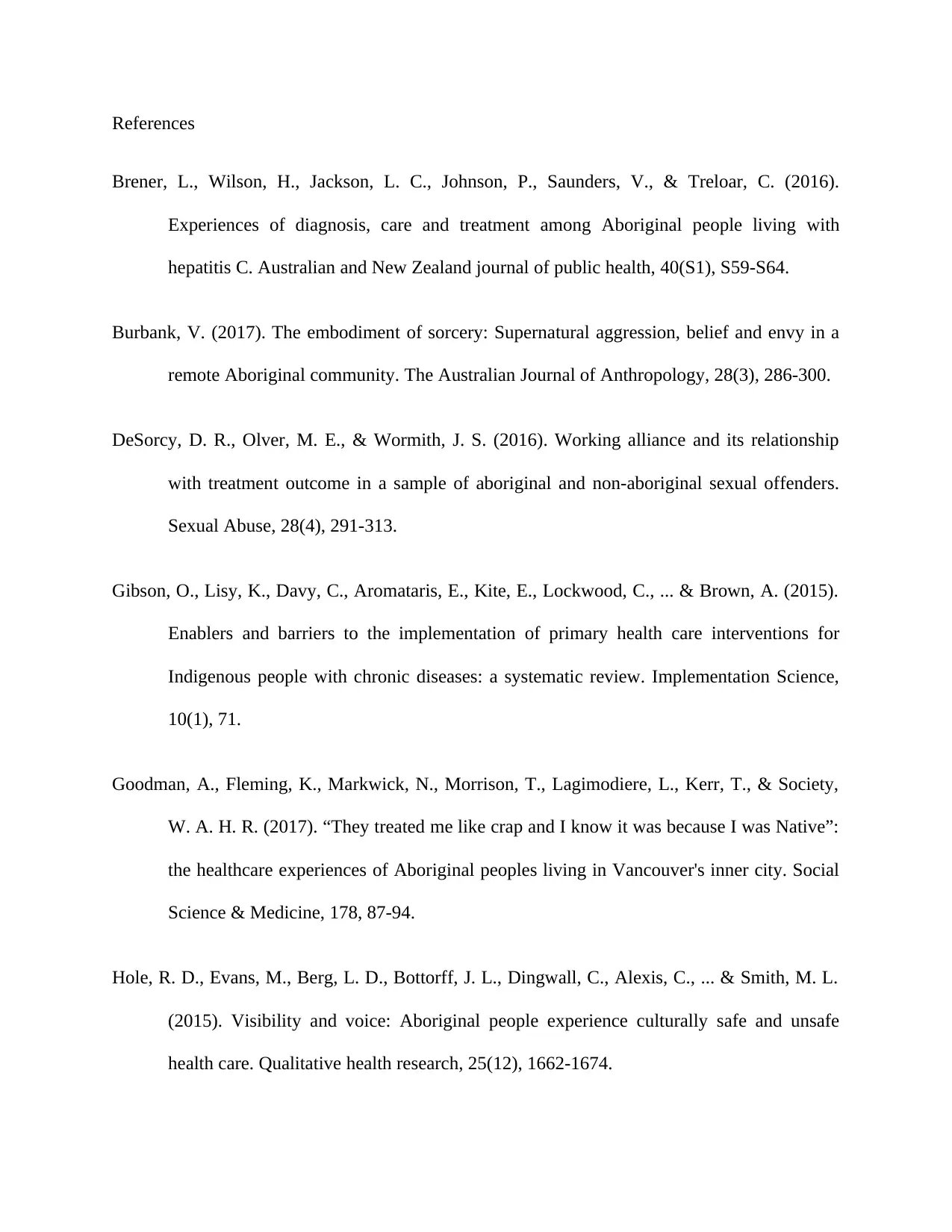
References
Brener, L., Wilson, H., Jackson, L. C., Johnson, P., Saunders, V., & Treloar, C. (2016).
Experiences of diagnosis, care and treatment among Aboriginal people living with
hepatitis C. Australian and New Zealand journal of public health, 40(S1), S59-S64.
Burbank, V. (2017). The embodiment of sorcery: Supernatural aggression, belief and envy in a
remote Aboriginal community. The Australian Journal of Anthropology, 28(3), 286-300.
DeSorcy, D. R., Olver, M. E., & Wormith, J. S. (2016). Working alliance and its relationship
with treatment outcome in a sample of aboriginal and non-aboriginal sexual offenders.
Sexual Abuse, 28(4), 291-313.
Gibson, O., Lisy, K., Davy, C., Aromataris, E., Kite, E., Lockwood, C., ... & Brown, A. (2015).
Enablers and barriers to the implementation of primary health care interventions for
Indigenous people with chronic diseases: a systematic review. Implementation Science,
10(1), 71.
Goodman, A., Fleming, K., Markwick, N., Morrison, T., Lagimodiere, L., Kerr, T., & Society,
W. A. H. R. (2017). “They treated me like crap and I know it was because I was Native”:
the healthcare experiences of Aboriginal peoples living in Vancouver's inner city. Social
Science & Medicine, 178, 87-94.
Hole, R. D., Evans, M., Berg, L. D., Bottorff, J. L., Dingwall, C., Alexis, C., ... & Smith, M. L.
(2015). Visibility and voice: Aboriginal people experience culturally safe and unsafe
health care. Qualitative health research, 25(12), 1662-1674.
Brener, L., Wilson, H., Jackson, L. C., Johnson, P., Saunders, V., & Treloar, C. (2016).
Experiences of diagnosis, care and treatment among Aboriginal people living with
hepatitis C. Australian and New Zealand journal of public health, 40(S1), S59-S64.
Burbank, V. (2017). The embodiment of sorcery: Supernatural aggression, belief and envy in a
remote Aboriginal community. The Australian Journal of Anthropology, 28(3), 286-300.
DeSorcy, D. R., Olver, M. E., & Wormith, J. S. (2016). Working alliance and its relationship
with treatment outcome in a sample of aboriginal and non-aboriginal sexual offenders.
Sexual Abuse, 28(4), 291-313.
Gibson, O., Lisy, K., Davy, C., Aromataris, E., Kite, E., Lockwood, C., ... & Brown, A. (2015).
Enablers and barriers to the implementation of primary health care interventions for
Indigenous people with chronic diseases: a systematic review. Implementation Science,
10(1), 71.
Goodman, A., Fleming, K., Markwick, N., Morrison, T., Lagimodiere, L., Kerr, T., & Society,
W. A. H. R. (2017). “They treated me like crap and I know it was because I was Native”:
the healthcare experiences of Aboriginal peoples living in Vancouver's inner city. Social
Science & Medicine, 178, 87-94.
Hole, R. D., Evans, M., Berg, L. D., Bottorff, J. L., Dingwall, C., Alexis, C., ... & Smith, M. L.
(2015). Visibility and voice: Aboriginal people experience culturally safe and unsafe
health care. Qualitative health research, 25(12), 1662-1674.
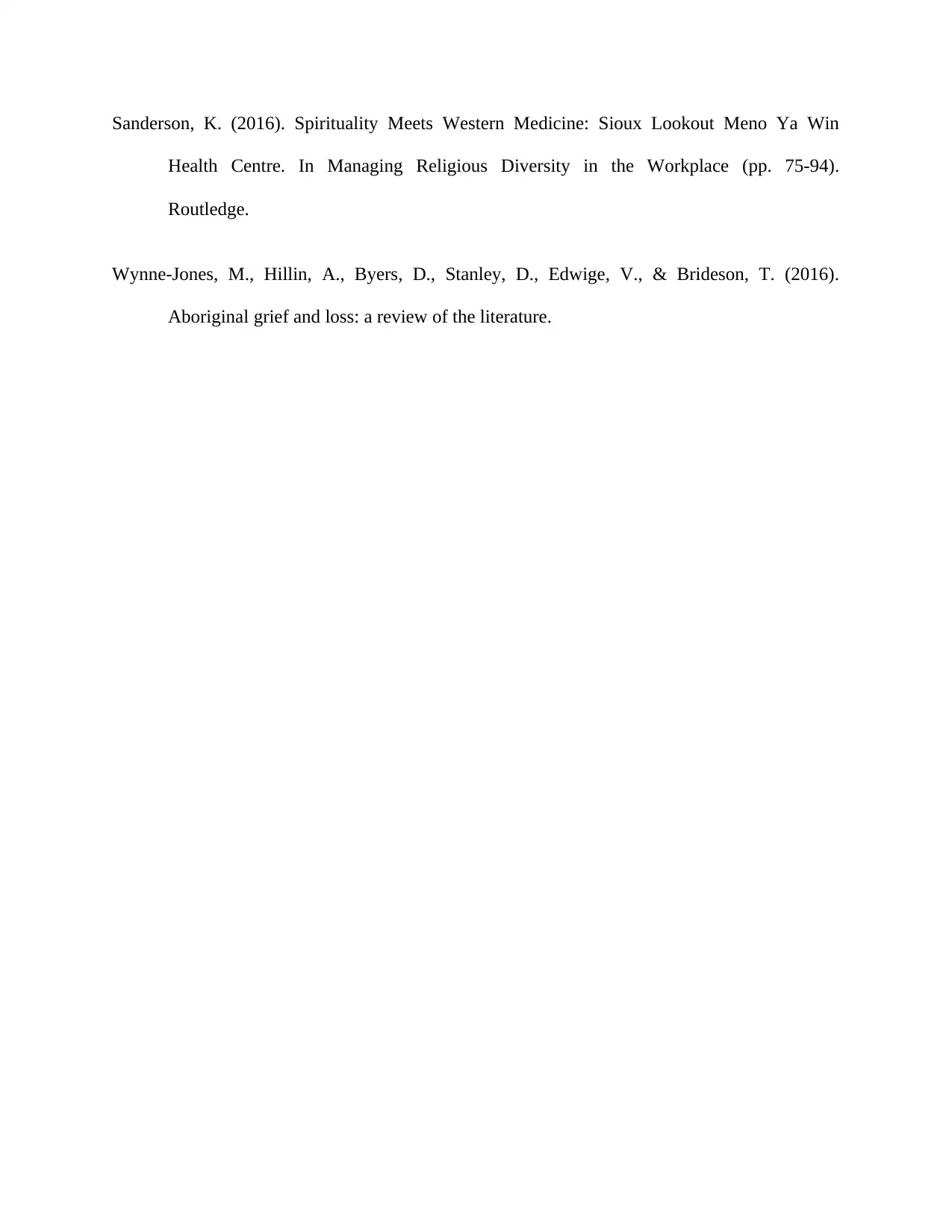
Sanderson, K. (2016). Spirituality Meets Western Medicine: Sioux Lookout Meno Ya Win
Health Centre. In Managing Religious Diversity in the Workplace (pp. 75-94).
Routledge.
Wynne-Jones, M., Hillin, A., Byers, D., Stanley, D., Edwige, V., & Brideson, T. (2016).
Aboriginal grief and loss: a review of the literature.
Health Centre. In Managing Religious Diversity in the Workplace (pp. 75-94).
Routledge.
Wynne-Jones, M., Hillin, A., Byers, D., Stanley, D., Edwige, V., & Brideson, T. (2016).
Aboriginal grief and loss: a review of the literature.
⊘ This is a preview!⊘
Do you want full access?
Subscribe today to unlock all pages.

Trusted by 1+ million students worldwide
1 out of 9
Related Documents
Your All-in-One AI-Powered Toolkit for Academic Success.
+13062052269
info@desklib.com
Available 24*7 on WhatsApp / Email
![[object Object]](/_next/static/media/star-bottom.7253800d.svg)
Unlock your academic potential
Copyright © 2020–2025 A2Z Services. All Rights Reserved. Developed and managed by ZUCOL.





